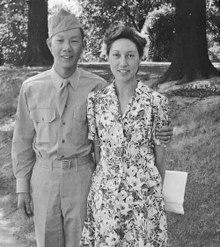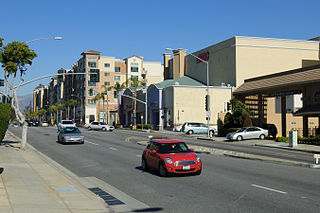
Monterey Park is a city in the western San Gabriel Valley region of Los Angeles County, California, United States, approximately seven miles (11 km) east of the Downtown Los Angeles civic center. It is bordered by Alhambra, East Los Angeles, Montebello and Rosemead. The city's motto is "Pride in the past, Faith in the future".

Chinatown is a neighborhood in Downtown Los Angeles, California, that became a commercial center for Chinese and other Asian businesses in Central Los Angeles in 1938. The area includes restaurants, shops, and art galleries, but also has a residential neighborhood with a low-income, aging population of about 7,800 residents.

The Asian-American influx to the San Gabriel Valley grew rapidly when Chinese began settling in Monterey Park, California, in the western San Gabriel Valley in the 1970s. Just east of Los Angeles, the region has achieved international prominence as a hub of overseas Chinese, or hua qiao. Although Chinese immigrants were a noteworthy presence in the establishment of Southern California from the 19th century, significant Chinese migration to suburban San Gabriel Valley coincided with a trend of white out-migration from the 1970s onward. This opened an opportunity for middle-class Asian Americans to begin settling in the San Gabriel Valley.

The Pui Tak Center, formerly known as the On Leong Merchants Association Building, is a building located in Chicago's Chinatown. Designed by architects Christian S. Michaelsen and Sigurd A. Rognstad, the building was built for the On Leong Merchants Association and opened in 1928. The Association used it as an immigrant assistance center, and the building was informally referred to as Chinatown's "city hall". In 1988, the FBI and Chicago Police raided the building as part of a racketeering investigation. The US federal government seized the building that same year.

Wah Ching is a Chinese American criminal organization and street gang that was founded in San Francisco, California in 1964. The Wah Ching has been involved in crimes including narcotic sales, racketeering, and gambling.

Cathay Bank is a Chinese American bank founded in 1962.
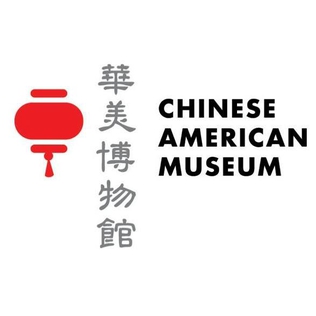
The Chinese American Museum is a museum located in Downtown Los Angeles as a part of the El Pueblo de Los Angeles Historic Monument. It is dedicated to the history and experience of Chinese Americans in the state of California, the first such museum in Southern California. It presents exhibits of fine art by Chinese American artists as well as historical exhibits.

Delbert Wong was the first judge in the continental United States of Chinese descent.

On Gold Mountain: The One-Hundred-Year Odyssey of My Chinese-American Family describes 100 years of author Lisa See's family history, providing a complex portrait of her family’s hard work, suffering, failures and successes as they moved from China to the United States. Speaking of the Chinese side of her family, See has said: "Things were so fractured and wild at home ... But the weekends with my grandparents became the real center for me ... It was the side of the family I identified more with. It was fun, romantic, solid".

Chinese Historical Society of Southern California is an historical society and organization based in Los Angeles Chinatown, California. There are monthly meetings, field trips, archive and library collections, oral history projects, scholarships, and publications.
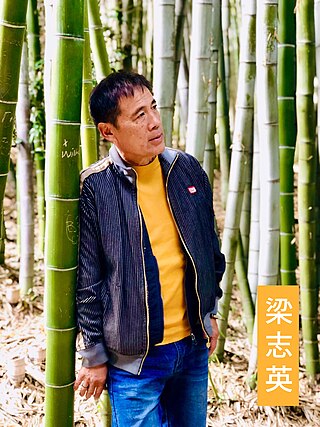
Russell Charles Leong is an academic editor, professor, writer, and long-time Chen-style tai chi student. The long-time editor of Amerasia Journal (1977–2010), Leong was an adjunct professor of English and Asian-American Studies at University of California, Los Angeles and currently serves as senior editor for international projects. He is the founding editor of the CUNY FORUM: Asian American / Asian Studies, published by the Asian American / Asian Research Institute - CUNY, and served as a Dr. Thomas Tam Visiting Professor at Hunter College/CUNY. He is the author of Phoenix Eyes and Other Stories which received the American Book Award. His most recent publication, MothSutra, a graphic poem about New York City restaurant bicycle deliverymen, was released in 2015.

Chinatowns are enclaves of Chinese people outside of China. The first Chinatown in the United States was San Francisco's Chinatown in 1848, and many other Chinatowns were established in the 19th century by the Chinese diaspora on the West Coast. By 1875, Chinatowns had emerged in eastern cities such as New York City, Boston, Pittsburgh, and Philadelphia. The Chinese Exclusion Act of 1882 barred Chinese immigration to the United States, but the Magnuson Act of 1943 repealed it, and the population of Chinatowns began to rise again.
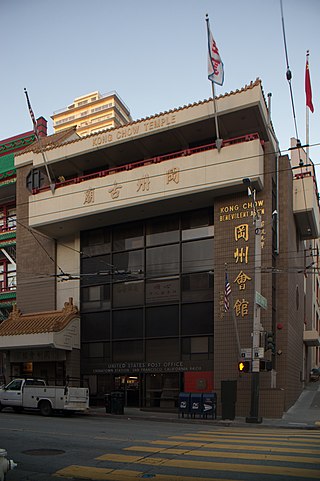
Kong Chow Temple is a temple dedicated to Guan Di, located in the Chinatown neighborhood of San Francisco, California, in the United States.

Helen Liu Fong was an American architect and interior designer from Los Angeles, California. Fong was an important figure in the Googie architecture movement, designing futuristic buildings like Norms Restaurant, the Holiday Bowl, Denny's, Bob's Big Boy, and Pann's Coffee Shop that helped usher in an era of boomerang angles, dynamic forms and neon lights. Fong became one of the first women to join the American Institute of Architects, and worked with Armet and Davis on many of her most well-known projects. Many of Fong's best-known building designs feature large glass fronts and bold colors on interior walls, designed to stand out and entice potential customers.
Gin Dan Wong was a Chinese-born American architect based in Los Angeles, California. During his career, he was the chief of the Architectural Guild for the School of Architecture and Fine Arts at University of Southern California, the founder and chairman of Gin Wong Associates, and the president of William L. Pereira Associates.

The Dragon Gate is a south-facing gate at the intersection of Bush Street and Grant Avenue, marking a southern entrance to San Francisco's Chinatown, in the U.S. state of California. Built in 1969 as a gift from the Republic of China (Taiwan) in the style of a traditional Chinese pailou, it became one of the most photographed locations in Chinatown, along with the older Sing Fat and Sing Chong buildings.

Ping Yuen and North Ping Yuen form a four-building public housing complex in the north end of Chinatown, San Francisco along Pacific Avenue. In total, there are 434 apartments. The three Pings on the south side of Pacific were dedicated in 1951, and the North Ping Yuen building followed a decade later in 1961. Some of the largest murals in Chinatown are painted on Ping Yuen, which are prominent landmark buildings taller than the typical two- or three-story Chinatown buildings that date back to the early 1900s.

Old Chinatown, or original Chinatown, is a retronym that refers to the location of a former Chinese-American ethnic enclave enforced by legal segregation that existed near downtown Los Angeles, California in the United States from the 1860s until the 1930s. Old Chinatown included the former Calle de los Negros and extended east across Alameda Street to Apablasa, Benjamin, Jeannete, Juan, Marchessault, and Macy Streets. This Chinatown was at its commercial and communal peak between 1890 and 1910.
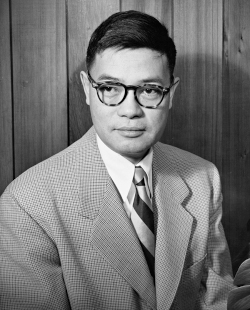
Eugene Kinn Choy (1912–1991) was a Chinese-American architect best known for designing the Cathay Bank headquarters in Chinatown (1962–66) and several private residences in the Silver Lake neighborhood of Los Angeles. He was the second Chinese-American to join the American Institute of Architects, following I. M. Pei, and one of the earliest to graduate from the School of Architecture at the University of Southern California.

China City, Los Angeles was a short-lived "Chinatown" tourist attraction developed by Christine Sterling, who also worked on the conversion of a neglected street into the Mexican-themed Olvera Street. She conceived of a similar plan for the displaced Chinese-American population following the demolition of Old Chinatown, Los Angeles.
